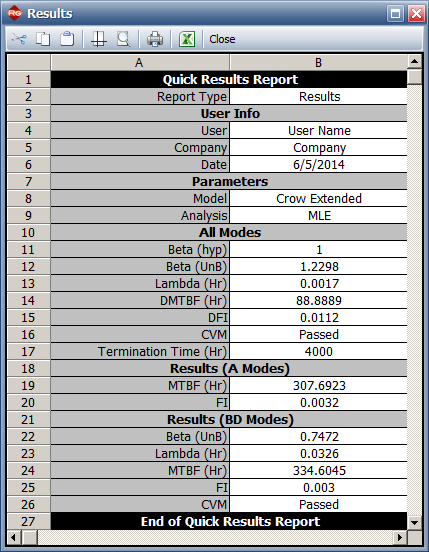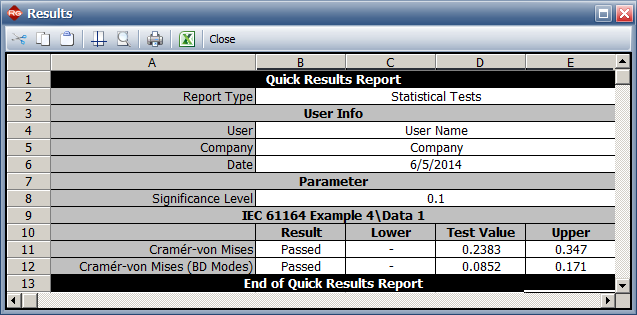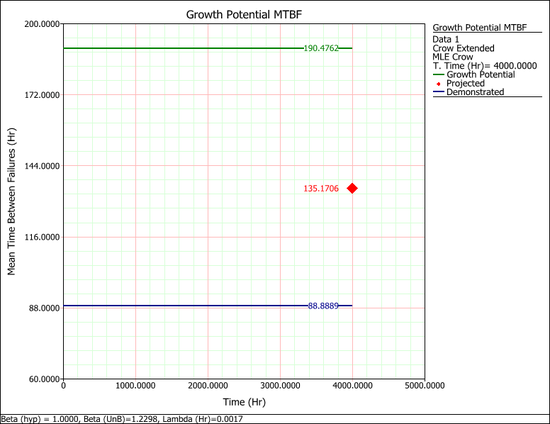Test-Find-Test Data Reference Example: Difference between revisions
Jump to navigation
Jump to search
No edit summary |
Kate Racaza (talk | contribs) No edit summary |
||
| (15 intermediate revisions by 2 users not shown) | |||
| Line 1: | Line 1: | ||
{{ | {{Reference Example|{{Banner RGA Reference_Examples}}|Test-Find-Test Data}} | ||
This example | This example validates the results for test-find-test data in RGA. | ||
| Line 6: | Line 6: | ||
International Standard IEC 61164 (Reliability Growth in Product Design and Test – Statistical Test and Estimation Methods), Example 4, pg. 32. | International Standard IEC 61164 (Reliability Growth in Product Design and Test – Statistical Test and Estimation Methods), Example 4, pg. 32. | ||
For this example, the following will be calculated: | |||
*Parameters of the Crow Extended model | |||
*Unseen BD mode failure intensity | |||
*Cramér-von Mises (CVM) goodness of fit for BD modes | |||
*Demonstrated MTBF (DMTBF) | |||
*Projected PMTBF (PMTBF) | |||
{{Reference_Example_Heading2}} | {{Reference_Example_Heading2}} | ||
{| {{table}} | The following table shows the data. | ||
{| {{table|15%}} | |||
!Failure Time | !Failure Time | ||
!Classification Mode | !Classification Mode | ||
| Line 106: | Line 113: | ||
| 3952||BD16 | | 3952||BD16 | ||
|- | |- | ||
|+'''Termination Time = 4000 hours''' | |||
|} | |} | ||
{| {{table}} | {| {{table|15%}} | ||
!BD Mode | !BD Mode | ||
!EF | !EF | ||
| Line 150: | Line 158: | ||
{{Reference_Example_Heading3}} | {{Reference_Example_Heading3}} | ||
BetaBD (UnB) = 0.7472, LambdaBD = 0.0326 | The book has the following results: | ||
*BetaBD (UnB) = 0.7472, LambdaBD = 0.0326 | |||
Unseen BD Mode Failure Intensity = 0.0030/hr | *Unseen BD Mode Failure Intensity = 0.0030/hr | ||
Goodness of fit for BD modes: CVM = 0.085, critical value = 0.171 with significance level = 0.1. Since CVM < critical value can fail to reject hypothesis that the model fits the data. | *Goodness of fit for BD modes: CVM = 0.085, critical value = 0.171 with significance level = 0.1. Since CVM < critical value can fail to reject hypothesis that the model fits the data. | ||
DMTBF = 88.9 hours | *DMTBF = 88.9 hours | ||
PMTBF = 135.1 hours | *PMTBF = 135.1 hours | ||
{{Reference_Example_Heading4| | {{Reference_Example_Heading4|RGA}} | ||
In RGA, the Crow Extended model with the maximum likelihood estimation (MLE) method was used to calculate the results. | |||
For a test-find-test, the assumption is <math>\,\!\beta =1</math>. Therefore: | |||
::<math>\begin{align} | ::<math>\begin{align} | ||
| Line 170: | Line 182: | ||
=&\frac{4000}{45}\\ | =&\frac{4000}{45}\\ | ||
\\ | \\ | ||
=&88.8889 | =&88.8889\; \; \mathrm{hours} | ||
\end{align}\,\!</math> | \end{align}\,\!</math> | ||
*The model parameters are: | |||
[[image:IEC 61164 Example 4_Results.png|center]] | [[image:IEC 61164 Example 4_Results.png|center]] | ||
| Line 191: | Line 205: | ||
PMTBF=&\frac{1}{\lambda _{p}}\\ | PMTBF=&\frac{1}{\lambda _{p}}\\ | ||
\\ | \\ | ||
=&135.17 | =&135.17 \; \; \mathrm{hours} | ||
\end{align}\,\!</math> | \end{align}\,\!</math> | ||
*The growth potential MTBF plot: | |||
[[image:IEC 61164 Example 4_Plot.png|center|550px]] | [[image:IEC 61164 Example 4_Plot.png|center|550px]] | ||
Latest revision as of 18:26, 28 September 2015
New format available! This reference is now available in a new format that offers faster page load, improved display for calculations and images and more targeted search.
As of January 2024, this Reliawiki page will not continue to be updated. Please update all links and bookmarks to the latest references at RGA examples and RGA reference examples.



